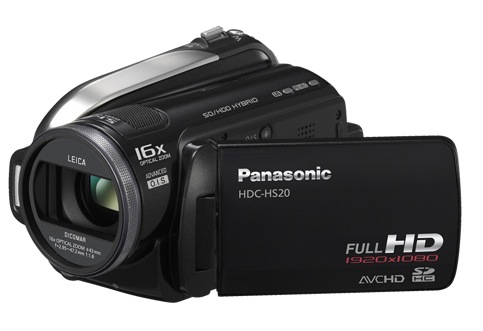 Picking up Pannie’s HDC-HS20 came at the wrong end of a group camcorder review, and I say the wrong end because the user fit with this camera was almost instant, unlike a lot of other shooters in the group, which took a bit of getting used to. Perhaps it’s because I’ve used a lot of Panasonic cameras that this one felt so easy to handle. Or not.
Picking up Pannie’s HDC-HS20 came at the wrong end of a group camcorder review, and I say the wrong end because the user fit with this camera was almost instant, unlike a lot of other shooters in the group, which took a bit of getting used to. Perhaps it’s because I’ve used a lot of Panasonic cameras that this one felt so easy to handle. Or not.
This is the first Pannie I’ve used with a touchscreen display, and I’d say it matches Sony’s touchscreen efforts for usability, perhaps just a tad more intuitive, though not as elegantly implemented.
Controls-wise, the HS20 is a minimal beast, with menu functions accessed via the touchscreen, leaving only the bare essentials on the body. Advanced users might think it’s a bit too bare. So yes, it’s easy to use. But it’s easy because you really have to try to mess it up. As an auto-everything shooter, it’s well put together.
A lot of cameras in this class skimp on optical zoom range but the Pannie has a useful 16x zoom. But it’s the camera’s autofocus and exposure handling that won me over. While shooting some test footage, I found that a distant subject at one end of a pan and a close subject at the other end of the pan were handled beautifully by the AF, with a smooth focus transition from far to near subject that had the look of a professional pull-focus technique.
Other cameras I’ve tried recently tend to hunt for the subject in this scenario, with the focus jittering in and out as the pan comes to an end. It was a nice surprise to see the Pannie re-focus purposefully and home in on the subject so positively. I tried a slow tilt shot as well, allowing gravity to pull the tripod’s fluid head down and camera up. The camera re-focussed on different points of interest through the tilt and did so pretty much as I would have done using manual focus.
This is a product of the HS20’s intelligent Auto (iA) with AF tracking, which Pannie says is designed to handle subjects as they move about the frame. Well, it works a treat, and you can tap the touchscreen to direct the AF to pinpoint a subject.
The other character of the camera scoring well was colour handling, with vibrant colours and depth to the footage, brought on by excellent auto exposure control. Actually, this was surprising given that the best quality setting records at 17Mbps to a single sensor. Other AVCHD camcorders in this price range ramp the max bitrate up to 24Mbps. That said, I think most Full HD AVCHD cameras these days are delivering the goods in video quality, at least under normal daylight conditions. The battleground seems to be in low-light conditions. Sony’s Exmor-equipped camcorders are pretty much leading the pack in this regard, and they have an edge on this Pannie, too.
Minor concerns
Gripes? A couple. There are two buttons on the flip-out display. One for deleting files and the other to access the system menu. They’re small, close together, and packed into the bottom, right-hand side, so meaty fingers will find them clumsy to handle. The other one is charging. The battery must be removed in order for the power supply to be plugged into the camera, and the battery has to be charged in a cradle, but you can’t charge the battery and power the camera at the same time. It’s a bit of nuisance value spoiling an otherwise fun to use camcorder. Also, here’s one camcorder you won’t buy for its still shots, which are pretty poor quality.
Turning to the unit’s specs, we have an 80GB HDD with SD/SDHC expansion. The sensor is a 1/6in MOS. It records 5.1 sound using five mics, has a Leica Dicomar 16x optical zoom lens, video light, optical image stabilisation, and a choice of four recording quality settings, from 6Mbps to 17Mbps. You can view the full specs here.
The HS20 carries an RRP of $1429 but you can do a lot better than that. This model has been around a while and a web search reveals you could find it for less than $900, which would make it a very good buy indeed.
For an amateur who just wants to pick up an easy to use camcorder and shoot, the HS20 would make a good fit, and its lovely AF and exposure handling will make them look good.